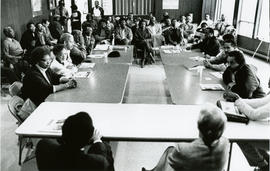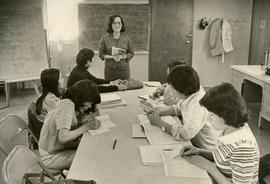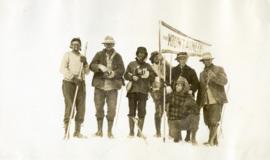The Mountaineers was founded in 1906. The following year, Charles and Henry Landes organized the first Tacoma area Mountaineers Local Walk. The walk, from American Lake to Steliacoom, was the third official outing of the The Mountaineers organization. The "Auxiliary to the Mountaineers" was organized in Tacoma in March of 1912. The Tacoma branch was active in organizing multi-day excursions in Longmire and Paradise. During the Great Depression, the group purchased the "Irish Cabin" and surrounding 18 acres of land near the Carbon Rover entrance to Mount Rainier National Park. The Cabin provided a gathering place for chapter events and sleeping quarters for 60 members at a time. The group maintained the cabin until 1978. In 1956, they opened the Tacoma Program Center in Old Town. The building was designed by Silas Nelson of Tacoma. The group hosts excursions, events, classes, and youth programs.
Member Biographies
Catherine Seabury
Catherine Seabury (1880-1970) was an active member of the Tacoma Branch of the Mountaineers, participating in outings and climbs and contributing photographs to the Mountaineer Bulletin. Originally from Peoria, Illinois, by 1919 she and her widowed mother were living together in Tacoma at 3810 N Washington, where she cultivated prize-winning roses. She was employed as a teacher at Sherman and Point Defiance Elementary Schools among others and spent additional time in the mountains at the family cabin in Paradise Valley. She moved to the Franke Tobey Jones Home in 1937, and died in Tacoma in 1970 at the age of 89.
Alma Wagen
Alma Wagen (1878-1967) was the first woman employed as a climbing guide at Mount Rainier National Park. Born in Minnesota, Alma arrived in Tacoma after graduating from the University of Minnesota. First employed at Whitman School, she taught mathematics at Stadium High School beginning in 1909 and had joined the Mountaineers by 1913. Her summer vacations were spent trekking in the Cascade and Olympic Mountains in Washington, Glacier National Park, and Alaska. In 1915 she summited Mt. Rainier for the first time, with a Mountaineer party. When World War I created a shortage of available men, she joined the National Park Service and was the first female guide to work at Mount Rainier. She guided John D Rockefeller, Jr. and his party “like a master”, according to Joseph Hazard, chief climbing guide at the time. In the spring of 1922 she moved to Yosemite National Park, and by the summer had returned to Rainier.
In 1926 at the age of 48 she retired from guiding and married Dr. Horace J Whitacre. A widower with two young sons, he too was a Mountaineer as well as a tennis player and yachtsman. He was a fellow of the American College of Surgeons, and the North Pacific Surgical Society, president of Tacoma Rotary Club as well as president of the Tacoma Chamber of Commerce. Alma began to be active in civic affairs, being chosen in 1933 to lead Tacoma women in implementing the National Recovery Act. She then served as president of the Ladies’ Auxiliary of the Washington State Medical Association, president of the Tacoma Y.W.C.A., and hosted dinners and gatherings at her home at 3803 N Monroe St. After the death of her husband in 1944, she moved to Claremont, California. There she competed in numerous bridge tournaments and did fund-raising for the local Community Chest. She died in 1967 at the age of 89 and is buried at New Tacoma Cemetery.
Willard G. Little
Willard G. Little (1870-1955) and Walter S. Little (1874-1958) arrived in Tacoma from Minnesota with their parents in the first decade of the 1900s. The two brothers remained close their entire lives, Walter living at 2121 N Washington with their parents, and Willard moving one block away, at 2219 N Washington, where he raised his family while working as an accountant. They both joined the Mountaineers, as well as the North End Shakespeare Club, and Willard also named his son Walter (B.). Walter (S.) was employed by the Bank of California and remained single. Willard chaired the Tacoma Branch of the Mountaineers from 1933-1936. It is thought that the photo album in the collection depicts him at this time, although the principal subject is referred to only as “he who needs no introduction”.
Willard’s son Walter B. Little (1909-2002) participated in the Tacoma chapter as a young man, then moved to Seattle and was very active in the Mountaineers there. He would be instrumental in developing the practice of ski mountaineering in Washington State through his work with the club.
Stella Kellogg
Stella Kellogg (1896 -1972) was born in Wyoming and moved to Tacoma in 1927. A member of the Mountaineers from 1931, she climbed the six major Cascade volcanic peaks and was recognized with an award in 1970. She was employed as executive secretary by the Pierce County Tuberculosis and Respiratory Disease Association for 34 years. Active in civic affairs, she was a charter member of the Tacoma Altrusa Club, a member of the University-Union Club, Tacoma Audubon Society and an alumna of the Kappa Delta sorority. She remained single and died in Tacoma at the age of 76.
Minnie Hutchinson
Minnie Hutchison (also Hutchinson) (c.1876- c.1941) was a member of the Tacoma Mountaineers c.1908 - 1917. In 1915, she participated in a publicity stunt developed to promote tourism and bring attention to Tacoma and its proximity to Mount Rainier National Park. On April 27, four cars and a Milwaukee Road train left Tacoma in a race to Ashford. A film cameraman, B.B.Dobbs of the Hobbs Totem Film Company was on hand to document the event and produce a film. Titled “Fours Hours From Tacoma to the Glaciers”, the film was intended to be shown at the San Francisco Panama-Pacific International Exposition and elsewhere. Minnie was a passenger in a car driven by Mrs. O.H. Ridgeway. They drove the 48 miles to Ashford and arrived first before the other three cars, although the train had bested them by just minutes. A prize consisting of a bag of gold coins worth $1000 was awarded to the train personnel, who promptly transferred it to the Mrs.Ridgway. Both before and after the race, promotional events and photographs were arranged, in which Minnie took part.
She worked as an assistant to her brother Ralph Hutchison, a dentist. At some point after his death in 1931, she moved to Oregon and was employed as a housekeeper.
A.H. Denman
Asahel H. Denman (1859-1941) was a principal founder of the Tacoma Branch of the Mountaineers. In 1912, along with John B. Flett and Harry Weer, he organized the meeting that established its by-laws and constitution. He was elected chairman and started the Tacoma winter outings that year.
Born in in New York, he studied law at the State University of Iowa, graduating in 1885. By 1890 he had arrived in Tacoma and began practicing law here in 1894. He joined the Mountaineers in 1909 and climbed the six principal peaks of the Cascades, as well as organizing and participating in many annual and local outings. An avid amateur photographer, he concentrated on documenting the features of Mount Rainier, two of which were named for him (Denman Falls and Denman Peak). He provided photographs and articles to the Mountaineer Bulletin, and delivered illustrated lectures to church and school groups around the state. He advocated changing the mountain’s name to Mount Tacoma and in 1924 wrote a book presenting his views, The Name of Mount Tacoma. He never married and died in Tacoma at the age of 81.
John F. Gallagher Jr.
John F. Gallagher, Jr. (Jack) (1925-2015) was born in Tacoma, and had joined the Tacoma Branch of the Mountaineers by the age of thirteen. He attended Stadium High School and was active in Boy Scouts, attaining the rank of Eagle Scout. He enlisted in the US Navy in World War II, serving in the Pacific aboard the USS Wilkes-Barre. In 1950, he received a BS in Civil Engineering from Santa Clara University and began his career with the Washington State Department of Transportation as a project engineer. The Tacoma Branch of the Mountaineers elected him chairman for 1952-1954. He had a particular interest in skiing and was one of the few leaders of ski tours in the mid-fifties. He continued his involvement with Scouting, serving as Scoutmaster for 33 years from 1950 through 1983. He died in University Place, Washington in 2015 at the age of 89.
Josephine and Stella Scholes
Two Scholes sisters, Josephine (1874-1961) and Stella (1876-1934), collected the materials here. Their parents brought seven children to Tacoma in 1890 via Illinois, Missouri, Iowa, and Kansas. All five daughters worked as teachers, and at least three of them, Josephine, Stella, and Emma, participated in Mountaineer outings in their summer vacations.
Josephine, the second oldest daughter, was born in Missouri and taught at the elementary level initially, at Bryant, Franklin, Grant, and Willard Schools. The remainder of her career, from 1933 until retirement in 1940, was spent at Jason Lee Junior High School. She maintained daily entries in three diaries during summer outings.
Stella, the fourth child and third daughter, was first employed at Central School, then taught algebra and geometry at Stadium High School until her death at the age of 58. She climbed the six major peaks of Washington State and served as secretary-treasurer for the Tacoma Branch. She was a member of the 1909 expedition to the summit of Mount Rainier, sponsored by the Mountaineers and offered as a side trip for visiting suffrage conventioneers. Participants planted a pennant from the Alaska-Yukon-Pacific Exposition with the motto “Votes for Women” on the summit.
Clarence Garner
Clarence Garner (1892 -1968) joined the Mountaineers in 1920 and soon began a life of active participation in the Tacoma Branch. He served as a member on the Local Walks Committee in 1924, and in 1925 acted as camp helper on the summer outing that year. Thereafter he was a regular helper and/or assistant cook on at least 35 outings and was known for his yodeling at the rising call. He acted in camp skits and pantomimes, singing “Acres of Clams” and other favorites. He was a “Six-Peaker”, and climbed Mount Rainier four times, Mount Baker three, Mounts Baker and St.Helens each twice. An avid amateur photographer, his photographs began to be featured in the annuals in the 1930s. While the bulk of his output was concentrated on the Mountaineers, his interests were varied and included documenting the Seattle Symphony, of which he was a patron, Daffodil Parades, and the construction of the Narrows Bridge. A vice president of the Tacoma Branch in 1931, he served as president in 1943 after having been awarded the Acheson Cup for outstanding service in 1937. A Trustee three times in the late 1940s and 1950s, he served variously as chairman of the Special Outings, Music, and Photography Committees. After the Tacoma Clubhouse was built in the 1960s he was caretaker, and documented the construction of the climbing pylon there.
Born in Buckley, Washington, he lived in Tacoma with his widowed mother until her death in 1932. He remained single and retired from St. Regis Paper. He died in Tacoma at the age of 78, having been a Mountaineer for 48 years.
Curtis & Miller
Curtis & Miller was a Seattle photographic studio that was in business from 1914 to 1916. Its principals were Asahel Curtis (1874-1941) and Walter Miller (1876- 1938).
Asahel Curtis was the younger brother of photographer Edward Curtis. Born in Minnesota in 1874, he moved with his family to the Puget Sound area in 1888. By 1895 he was working in the photography business with his brother in Seattle. He represented his brother’s studio on a trip to the Yukon in 1897, bringing his glass plate equipment into the gold fields. On his return in 1899, he discovered that Edward had taken credit for the trip and some of the resulting photographs, and that led to their lifelong estrangement. He continued working as a photographer with various partners and established his own studio in 1920.
He summited Mount Rainier in 1905 and made an early ascent of Mount Shuksan in 1906. Curtis Glacier on Mount Shuksan and Camp Curtis and Curtis Ridge in Mount Rainier National Park are named for him. In November of 1906 Frederick Cook came to Seattle on his return from his purported first ascent of Denali (then Mount McKinley) and spoke inspiringly of his expedition. That same month Curtis participated in the first meetings that organized the Mountaineers, Cook attending one. In December 1906 the Mountaineers were formed, with a constitution and by-laws, and Asahel Curtis was elected to the board of trustees. He organized and led the first summer outing to Mount Rainier in 1909, and was in the party that brought a pennant from the Alaska-Pacific-Yukon Exposition to the summit.
His involvement with the establishment of Mount Rainier National Park resulted in a break with the Mountaineers, as his ideas for its development differed from theirs. He served as the official photographer for the Seattle Chamber of Commerce and chaired its Development Committee and Highway Committee for years. His studio continued to document people, companies, and features of the state until his death in 1941. 60,000 of his images are held by the Washington State Historical Society.
Walter P. Miller was born in Illinois, and was in Seattle by 1900 and working as a photographer. In 1903 he accompanied explorer Frederick Cook as photographer on his first expedition to Denali, then known as Mount McKinley. He participated again as photographer on the controversial second expedition in 1906, when Cook claimed to have reached the summit, a claim that is now discredited. After Curtis & Miller was dissolved, he continued in the photography business in Seattle on his own until at least 1935. He died of a heart attack on his yacht in Anacortes, Washington in 1938.


